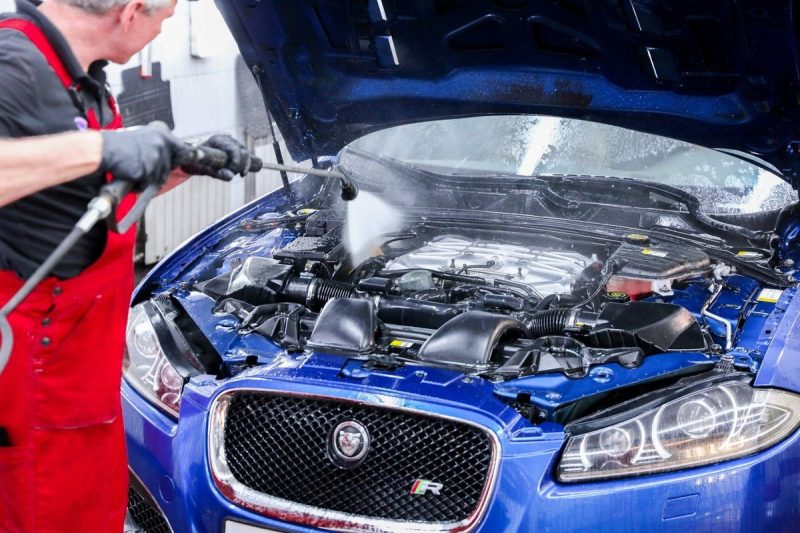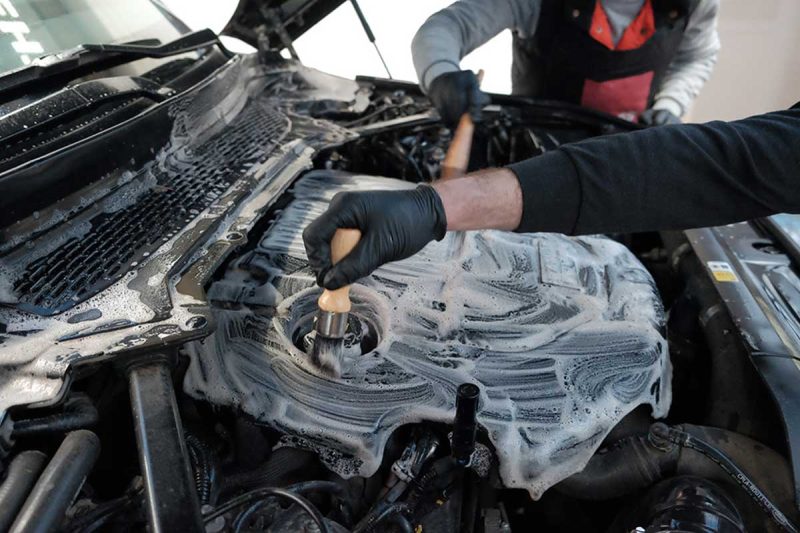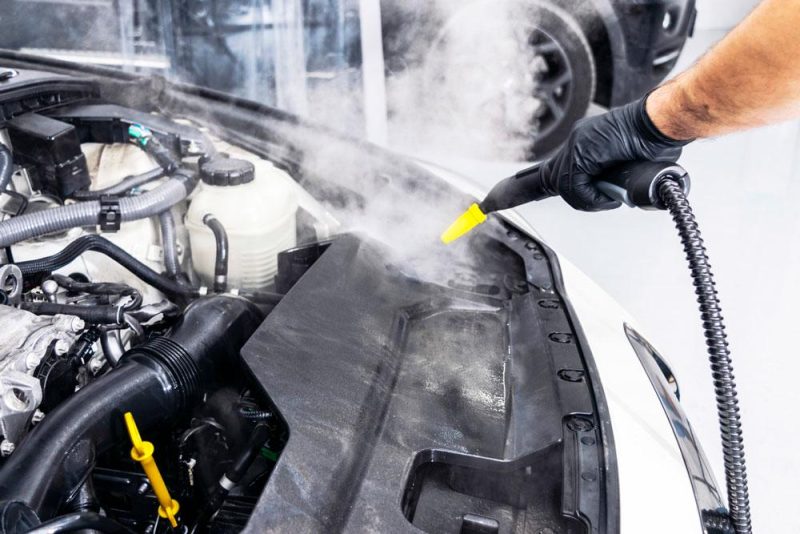The question “to wash or not to wash the engine” for many years causes fierce disputes among car owners. Some are sure that the engine, like the whole car, should be kept perfectly clean. And therefore, wash it more often. Others are convinced – often by their own sad experience – that this is an unnecessary procedure associated with a high risk of damaging the powertrain or attachments.
Another group of drivers simply never thought about washing the engine, looking under the hood only to check the oil level and refill the antifreeze. Let’s find out what can be fraught with washing the engine with your own hands, find out what to wash the motor and try to wash the engine correctly according to the instructions.
Why it is useful to wash the engine of the car
The most obvious argument for washing the engine is the tidy appearance of everything under the hood. However, it makes no sense to pedantically bring the engine “to a dazzling shine” – no one will see it anyway. So aesthetics can be considered the least important reason for washing.
More important is regular cleaning of the engine from dirt, chemical or oily deposits in inconspicuous and often hard-to-reach places. Otherwise, the engine itself, its attachments and the underhood will gradually become covered in a “coat” of dust and dirt. Because of this, heat exchange may be disturbed, current leaks may occur, sensors and servos may stop working normally. All this can cause abnormalities in engine operation and even create risks of car fire.
In addition, washing will slow down the processes of metal corrosion caused by aggressive reagents flying from the road. And it will protect from premature aging plastic parts, wire insulation, rubber bands, which are very much under the hood. In other words, it will prolong the life of the car.
Finally, you can wash the engine from the outside before its major repair – to assess the condition of oil seals and gaskets, serviceability of heat exchangers and to ensure cleanliness during disassembly/assembly of the unit.
What engine washing can hurt
The main argument “against” washing the engine compartment of the car is usually called the presence of wiring and electrical units (generator, starter, actuators) under the hood – and after all, we know from childhood that water and electricity – things badly compatible. In fact, this consideration is far from the main thing, because the electrical equipment of a modern car is originally designed to work in a humid environment and is not afraid of splashing water. And off-road vehicles are designed so that they can overcome serious fords, literally immersing the power unit in water.
Therefore, the threat to the car when washing the engine is not the liquid itself, but the pressure with which it is supplied. The impact of a jet from a hose or, worse, a high-pressure machine can “break” the seals on spark plugs and coils, wiring and sensors. It can also tear off cable clamps or clamps on lines, dampers on air ducts or clips of soundproofing mats. Protective covers on electronic units are also at risk of failing.
The problem is so serious that, for example, Audi engineers consider frequent washing of the car as one of the factors of Russian “hard operating conditions” – along with bad roads and low-quality fuel.

Another risk when washing the engine, especially with your own hands, is incorrectly selected detergents. What can be used to wash the engine? Active foam, which covers the body, is unsuitable for engines. It is very difficult to wash it off completely, and the residue is guaranteed to lead to oxidation of contact pairs. Only easily evaporating solvents or degreasing compositions are more dangerous. They may wash away dirt, but they are easily flammable and cause a fire.
Finally, overly caustic chemicals combined with overzealous washing can leach lubrication from vital connections. A throttle sticking open on the road risks making the car uncontrollable. A modern engine, controlled by electronics, can be protected against such a scourge, but an old carburetor unit is capable of failing and provoking a serious accident.
Wash or don’t wash
For many people, the above scenarios are a reason to refuse washing at all. However, it is still possible to keep the engine clean – the main thing is to do it correctly. Alas, the subject of engine washing is mired in advertising and often contains frankly harmful advice. Therefore, before making a final decision, try to study the reviews of owners of cars of the same make and model. Usually they are better informed than others about the vulnerabilities in the underhood of a particular car. This knowledge will help and in the case if you take up washing by yourself, and when you decide to entrust this procedure to specialists.
When it is necessary to wash the engine
Taking into account the pros and cons of the procedure, you can plan the cyclicity of engine washes. It is better to wash the engine in the spring to clean it from winter “chemistry”. If the underhood space of the car is designed so unsuccessfully that there is abundantly drawn in dirt with dust and during summer operation, then you can repeat the procedure before the onset of cold weather. And those who drive a lot on off-road or dusty primers, should wash the engine compartment even more often – to avoid “cementing” of dirt.
As for the service washing, it should be done only after the master has examined the car – some defects and drips are more convenient to diagnose on the unwashed engine. It is not excluded, by the way, that another washing will be required after repair.
For the same reason you should not wash the engine before selling the car. You are likely to do it out of good intentions to show the car in a favorable light, but a potential buyer may suspect you exactly the opposite – in the desire to hide defects. After all, a car that drives does not have a perfectly clean engine.
How to wash the engine at the sink
Deciding to wash the engine at the car wash, clarify what they mean by “engine washing” and what means are used by the masters. The so-called full, but at the same time low-budget washing is often reduced to splashing under the hood of some composition and its washing with the same device that washed the body. Such a procedure turns out to be very superficial – from the external parts of the motor and its plastic linings at best gather dust. And it is good if nothing is damaged on the engine itself.
Instead of such washing it is better to choose partial or local cleaning of underhood space with a vacuum cleaner – expenses of forces and means are almost the same, and benefits from clean radiators, pallets, air ducts to the engine will be more.
And how does a proper car engine wash look like at a car wash? This process is labor-intensive and not fast at all. Therefore, the cost of such a service at companies that specialize in detangling is usually much higher (usually from 1500 rubles). But here, too, it is worth asking about the reason for the price – some companies explain it by using some advanced or clever two-component washing formulations. Although, in fact, it turns out to be the same surface washing with some restorative effect.

Other firms wash the motor “according to the classics”, but more thoroughly – with preliminary protection of the most vulnerable units, partial dismantling of underhood elements, careful manual cleaning of the most difficult to reach places and so on. And here everything will depend on the experience of the master.
Now more and more often “safe washing” of the engine by dry steam is offered. As the advertisement assures, such washing is able to return the motor to the appearance of a brand new one. This, by the way, is not far from the truth, if the engine itself, of course, does not run out of oil or antifreeze. Steam cleaning is attractive because it is not so painful for the motor parts and electrical equipment, but it splits and removes contaminants well. However, it makes sense to pay a high price for the procedure only if steam cleaning is combined with cleaning of hidden elements of the underhood space: coolers, heat exchangers, air ducts….
And in all cases, the main criterion should be the warranty. If the company does not take responsibility for possible damage, it is better to look for another.
How and with what to wash the engine at home
If you decide to wash the engine with your own hands (which may not be as effective, but relatively safe), then first choose a suitable place – after the procedure, there will be a lot of dirt under the car. Therefore, do not clean the engine in the yard or in nature.
What you can wash the engine yourself
To wash the engine at home yourself, you will need a very small set: gloves, a roll of paper towels or dry and clean rags, several brushes-brushes of different sizes (paint brushes will do) and some kind of sprayer for liquid. Even a garden sprayer can act as the latter. It is also worth stocking up on plastic bags, fixing rubber bands and painter’s tape – they can cover the most vulnerable parts of electrical equipment.
What means are needed for washing the engine of the car
Means for cleaning the engine are made on a water basis or on the basis of petroleum refining products. The packaging is also different – just bottles, canisters with concentrates, sprays …. Choose the ones that will be easier for you to use – for this purpose, carefully study the instructions before buying. Methods of application may vary greatly: some compositions should be applied only on a warm engine, others require multiple applications or special flushing, others need to be diluted beforehand.
Also when buying special means in stores of auto chemicals it is worth to specify for what kind of washing they are suitable. The seller can mistakenly offer, for example, internal washing for the engine or in general some “raskokosovka”, the use of which outside can end sadly.
How to properly wash the engine yourself
First of all, make sure that all the elastic protective nozzles, caps and tubes are in place, installed properly and well fixed, the oil dipstick is inserted to the end, all plugs and caps are screwed on. If there are easily removable panels and parts that can be washed separately, it is better to dismantle them (this advice does not apply to covers, which serve just to protect against splashes). From electrical equipment it is advisable to cover the generator and cooling fan motor from direct water ingress. On older cars, be sure to protect the ignition distributor (trampler), ignition coil and high-voltage wires.
Before washing the engine, it’s a good idea to go through all ducts and recesses with a vacuum cleaner to clear them of debris and stray leaves, and cover the air duct inlets to keep water out.

Wait until the exhaust system cools down before applying detergent to the engine and the entire underhood – strictly according to the instructions.
It is better to wash off the dirt without pressure or not with a strong jet – it is safe for the components of the engine compartment. If a portable car wash is used to supply water, it should be turned on to the minimum pressure and a wide, not point spray of liquid. Brushes and brushes should be used for localized cleaning of heavily soiled parts.
After the engine is washed, if desired, you can apply a preservative for the underhood space. In the vast majority of these compositions are absolutely harmless and have an antistatic effect. Thanks to it, dust will slowly “sit” on clean surfaces.
After removing all the autochemistry it is necessary to dry the places of water accumulation with absorbent wipes, blow the contacts and terminals with compressed air (at least from a car pump or compressor), treat connectors and mechanisms with water-displacing liquid WD-40, update the lubrication of drives. At the end of the final drying – with the engine started for 5-10 minutes and lifted hood.
Totals
- Wash the engine is best after the end of winter (if there were minus temperatures). If the car is used on dusty roads or outside, the frequency of washing should be increased.
- Before selling the car or before a visit to the service, it is better not to wash the engine. Let the buyer or the master inspect it in “working” condition first. But if there is to be a responsible repair, then wash the engine must be obligatory.
- The very washing for the engine and its electrical equipment is not as terrible as everyone thinks, but the incompetence of the masters at the car wash and offers to “wash the engine quickly” are fraught with serious breakdowns. So choose large car washes with a serious approach and good reviews.
- There is nothing complicated about washing the engine yourself, especially if you stock up on the right tools and equipment. But it’s a dirty procedure, and it certainly won’t add cleanliness to the place where you’re going to realize it. So you should not do it in the yard or in nature.
- How to wash an engine safely? – Do not use high pressure and use only chemicals specifically designed for the engine compartment.
